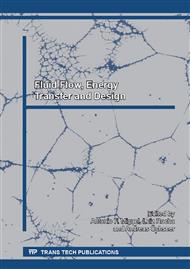[1]
S.M. You, T.W. Simon, A. Bar-Cohen, A technique for enhancing boiling heat transfer with application to cooling of electronic equipment, IEEE Trans. Compon., Hybrids, Manuf. Technol. 15 (1992) 823-831.
DOI: 10.1109/33.180048
Google Scholar
[2]
I. Mudawar, T.M. Anderson, Optimization of enhanced surfaces for high flux chip cooling by pool boiling, J. Electron. Packaging 115 (1993) 89-100.
DOI: 10.1115/1.2909306
Google Scholar
[3]
J.L. Parker, M.S. El-Genk, Enhanced saturation and subcooled boiling of FC-72 dielectric liquid, Int. J. Heat Mass Transfer 48 (2005) 3736-3752.
DOI: 10.1016/j.ijheatmasstransfer.2005.03.011
Google Scholar
[4]
K.C. Leong, L.W. Jin, Study of highly conductive graphite foams in thermal management applications, Adv. Eng. Mater. 10 (2008) 338-345.
DOI: 10.1002/adem.200700332
Google Scholar
[5]
I. Pranoto, K.C. Leong, L.W. Jin, The role of graphite foam pore structure on saturated pool boiling enhancement, Appl. Therm. Eng. 42 (2012) 163-172.
DOI: 10.1016/j.applthermaleng.2012.03.001
Google Scholar
[6]
V. Khanikar, I. Mudawar, T.S. Fisher, Effects of carbon nanotube coating on flow boiling in a micro-channel, Int. J. Heat Mass Transfer 52 (2009) 3805-3817.
DOI: 10.1016/j.ijheatmasstransfer.2009.02.007
Google Scholar
[7]
V. Sathyamurthi, H-S. Ahn, D. Banerjee, S.C. Lau, Subcooled pool boiling experiments on horizontal heaters coated with carbon nanotubes, J. Heat Transfer 131 (2009) 071501-1 – 071501-10.
DOI: 10.1115/1.3000595
Google Scholar
[8]
H-S. Ahn, V. Sathyamurthi, D. Banerjee, Pool boiling experiments on a nano-structured surface, IEEE Trans. Compon. Packag. Technol. 32 (2009) 156-165.
DOI: 10.1109/tcapt.2009.2013980
Google Scholar
[9]
N. Singh, V. Sathyamurthi, W. Peterson, J. Arendt, D. Banerjee, Flow boiling enhancement on a horizontal heater using carbon nanotube coatings, Int. J. Heat Fluid Flow 31 (2010) 201-207.
DOI: 10.1016/j.ijheatfluidflow.2009.11.002
Google Scholar
[10]
J.P. McHale, S.V. Garimella, T. S. Fisher, G.A. Powell, Pool boiling performance comparison of smooth and sintered copper surfaces with and without carbon nanotubes Nanoscale Microscale Thermophys. Eng. 15 (2011) 133-150.
DOI: 10.1080/15567265.2011.575918
Google Scholar
[11]
S. Shenoy, J.F. Tullius, Y. Bayazitoglu, Minichannels with carbon nanotube structured surfaces for cooling applications, Int. J. Heat Mass Transfer 54 (2011) 5379-5385.
DOI: 10.1016/j.ijheatmasstransfer.2011.08.005
Google Scholar
[12]
3M: Fluorinet Electronic Liquid FC-72 Product Information (2013).
Google Scholar
[13]
J.R. Taylor, An Introduction to Error Analysis, second ed., University Science Books, California, (1997).
Google Scholar


